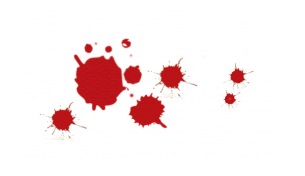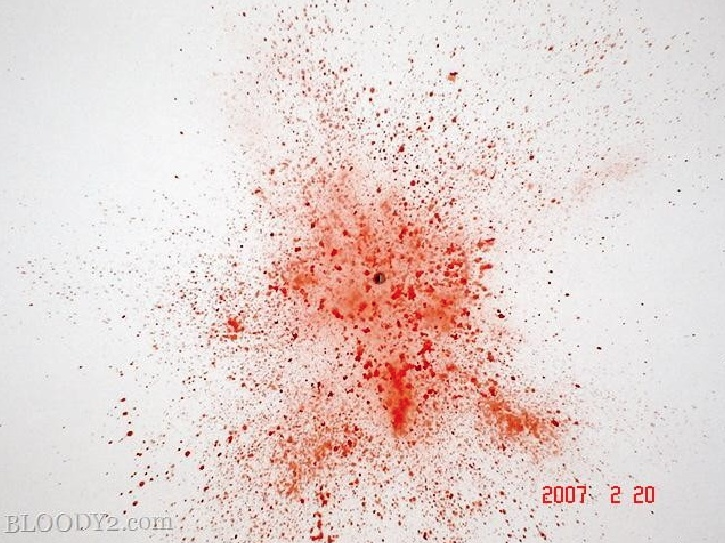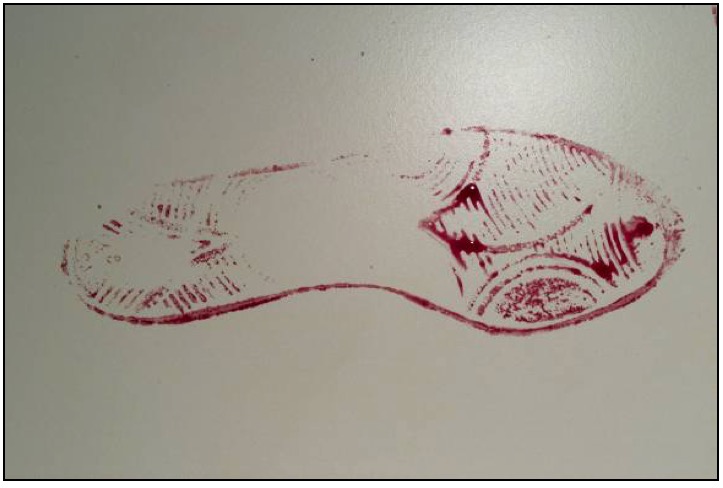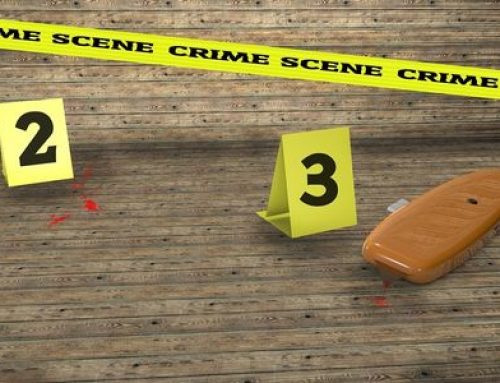Dead men tell no tales but blood spatters do.
The analysis of the shapes, patterns and locations of blood stains has become a field of specialization in forensic science to piece together how events unfolded during a shooting, stabbing or beating. Depending on the type of injury inflicted, blood can spurt, drip, gush, ooze, spray or flow as they leave the body.
Where the blood lands, how it lands, the size and shape of its droplets, and its consistency are useful in determining the facts of the crime. Besides helping reconstruct what took place during a violent incident, blood spatter analysis can identify the victim, determine who was responsible, and confirm or refute suspects or eyewitnesses’ accounts.
Here are the ways bloodstain patterns are analyzed:
Image Credit: here
Drip Stains
 Image credit: webstockreview
Image credit: webstockreview
A drip pattern results when a drop of blood falls into an existing bloodstain. As blood accumulates on a bloodied object, small drops can form that will eventually fall because of gravity. The blood dripping into blood can cause droplets to be released from the preexisting pool forming very small stains around the edge of the original blood drop.
This pattern traditionally represents a person who is bleeding and fleeing the scene of a crime. The drip trail can lead to the bleeding victim or suspect and also to the location where the assault took place.
Cast-off Pattern
Image credit: @Nitcop Slideshare
A cast-off pattern is created when blood is released from a blood-bearing object in motion. A baseball bat or hammer that is used to bludgeon a victim will cast off the blood that has accumulated on it when swung. The droplets of blood flung from the object create a trail of blood that looks like lines on walls and ceilings.
The resulting arcs can reconstruct where the assailant and victim were positioned. Multiple swings also produce overlapping cast-off patterns which can be counted to know the minimum number of blows delivered.
Gunshot Spatter (Misting)
Image credit: @Nitcop Slideshare
Gunshots produce fine droplets of blood spattered in a forward direction from the exit wound and in a backward direction from the entrance wound.
Normally, the forward spatter takes the form of a fine mist while the back spatter has larger and fewer drops. Where they vary depends on the size or the caliber of the bullet fired, where the victim is struck, the distance from the muzzle of the gun to the target, whether the bullet exits the body, and the location of the victim relative to walls, floors and objects.
Expirated Spatter
Image Credit: Study Blue
When airflow forces blood out of the nose, mouth or injured airway or lung, the resulting bloodstain pattern is known as an expirated spatter. The airflow is the propelling force that moves the air out of the body due to an internal injury caused by a stabbing or shooting.
The expirated blood often produce a discrete mist-like pattern with small air bubbles evident in the drops of blood. Saliva and nasal secretions can also be present to distinguish it from other kinds of spatter.
Impact Stain
Image Credit: Slideplayer
When blood is projected through the air resulting from an object striking the liquid, the pattern created is called an impact stain. Such spatter can either be low velocity that falls at the speed of normal gravity, medium velocity that has more force than gravity or high velocity with energy greater than 100 feet per second.
Low force impact spatter is usually associated with open wounds while medium force is typically seen in blunt force or stabbings. High force impact spatter, on the other hand, is obviously produced by gunshots, explosions, and high speed collisions.
Arterial Spray
Image credit: cristabuscheforensics.weebly.com
An arterial spray spatter is created when a major artery is punctured, and the continuous pumping of blood causes it to spurt out of the injured area. It often forms an arcing pattern consisting of large, individual stains, with a new pattern created each time the heart pumps.
It is usually of a brighter red color than other blood and found at some distance from the victim. The fine spray projected comes from gunshot or deep stab wounds and is often found on walls or ceilings.
Splash Pattern
A splash pattern is formed when a volume of blood falls or spills at once onto a surface and splashes outward. Shaped like exclamation points, it tends to have a cohesive look with little breakup of the blood into smaller stains though it’s surrounded by peripheral, elongated bloodstains.
The shape and position of the spatter pattern can help locate the position of the victim at the time of the attack. Splashes are uncommon in most violent crimes but naturally occurs in suicides where the victim shoots himself in the head while standing or sitting.
Flow Pattern
 Image credit: How Stuff Works
Image credit: How Stuff Works
A large quantity of blood that is deposited on a surface will flow downward as it is acted upon by gravity to produce a flow pattern. There can also be a change in the shape and direction of the bloodstain due to the movement of an object after blood flow was initiated or after it had dried. A flow pattern can be found on a victim, a thing or a surface in the crime scene and is judiciously studied to determine if any corpse was moved or if the crime scene was staged.
Pool Pattern
Image credit: IfsColorado
When a bleeding victim remains stationary for a period of time over a surface that is leveled and undisturbed, the accumulated blood is what is known as a pool pattern.
It is one of the most common types of bloodstain found on crime scenes that allows crime scene investigators to gauge how much blood was lost and to determine the time of the crime. It also indicates the position of the victim that allows such pool to form and provides evidentiary value as a wet sample. It is often associated with extensive bleeding brought by shooting or stabbing.
Transfer Pattern
 Image credit: IfsColorado
Image credit: IfsColorado
A transfer bloodstain is created when a wet, bloody object comes in contact with a surface that is not bloody. An example of such a stain would be the print left on a wall by a person with a bloody hand. A recognizable image of the original surface may be transferred to the second surface as it retains the shape of that object.
Want to learn more?
Check out this article on crime scene experiment kits and this one on Infamous Serial Killers Undone by Forensic Evidence.




 Image credit: webstockreview
Image credit: webstockreview




 Image credit: How Stuff Works
Image credit: How Stuff Works
 Image credit:
Image credit: 


